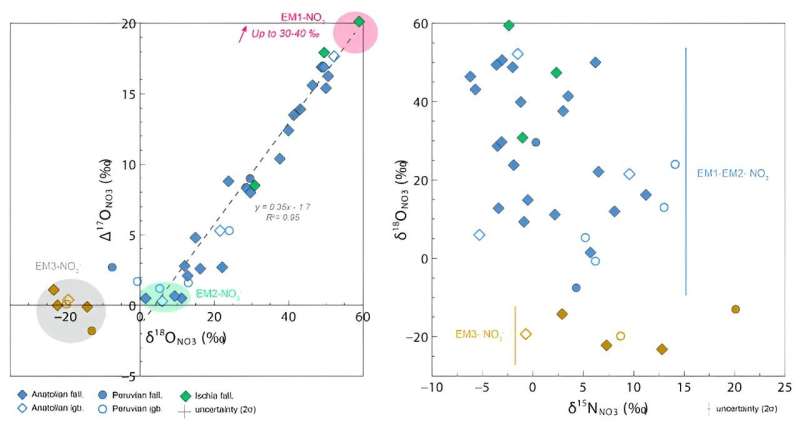February 6, 2024 report
This article has been reviewed according to Science X's editorial process and policies. Editors have highlighted the following attributes while ensuring the content's credibility:
fact-checked
peer-reviewed publication
trusted source
proofread
Looking into the possibility of volcanic lightning being the spark that ignited life on Earth

An international team of geologists, Earth scientists and mineralogists has found evidence suggesting that volcanic lightning may have fixed huge amounts of atmospheric nitrogen, allowing life on Earth to get its start.
In their study, published in the Proceedings of the National Academy of Sciences, the group collected and analyzed ancient volcanic deposits to learn more about how ancient eruptions may have produced nitrates that could have been used to create amino acids.
Prior research has shown that the development of life required fixing nitrogen, a key component of amino acids, during Earth's early years. In modern times, there is plenty of nitrogen in the atmosphere but plants cannot use it directly; it must first be fixed by bacteria that can convert it to nitrates or other nitrogen compounds.
That raises the question of how bacteria and then other life forms originated. In this new study, the researchers found evidence that nitrogen in the atmosphere could have been fixed by volcanic lightning interacting with ash.
Prior research has shown that lightning, whether due to thunderstorms or volcanic eruptions, can lead to the formation of nitrates under the right conditions. Lighting from thunderstorms has been ruled out as a candidate for production of the nitrates that led to the beginning of life due to the limited amounts that are produced.
To find out if the same held true for lightning produced during volcanic eruptions, the research team ventured to sites in Turkey, Italy and Peru, known to host ancient volcanic deposits. Samples from these sites contained large amounts of nitrates. Testing showed that they were atmospheric and had not come directly from the volcano—that left lightning as their likely source. But the thing that truly bolstered their theory was the huge amounts of nitrates they found, which were more than enough to serve as a source for creating amino acids.
The team notes that prior research efforts have led to theories that life began near volcanoes—and one team even found some evidence that suggested volcanic lightning interacting with volcanic gases could produce molecules used by living things, such as amino acids.
More information: Adeline Aroskay et al, Geological evidence of extensive N-fixation by volcanic lightning during very large explosive eruptions, Proceedings of the National Academy of Sciences (2024). DOI: 10.1073/pnas.2309131121
Journal information: Proceedings of the National Academy of Sciences
© 2024 Science X Network





















